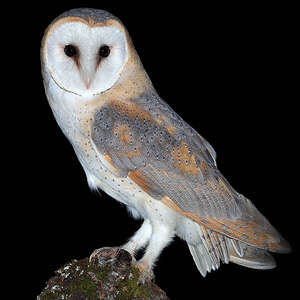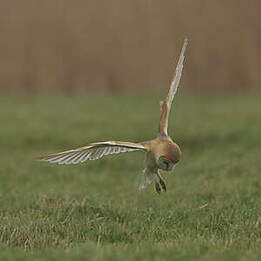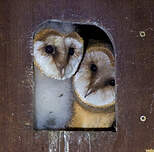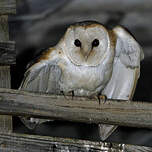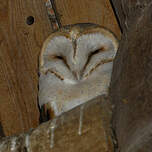Western Barn Owl
Tyto alba - Effraie des clochers Chouette effraie
Identification
The Western Barn Owl is a quite distinctive and easy to recognize medium-sized owl. Its pale heart-shaped facial mask surrounding its relatively small dark eyes is characteristic. When it is surprised during the day in its roost, it closes its eyes and contract its mask, which gives it a particular expression. The uppersides are grey and reddish, and finely spotted with white and black. The undersides vary from pure white to quite strong russet, with or without speckling. The remiges and rectrices are clearly barred with blackish. The long tarses are closely and evenly feathered with white or russet. The bill is pale, horn-coloured. The species includes 10 subspecies (formerly 28 before the "splits") but the plumage differences are not very important between them. The Western European ssp. "alba" is more white underneath than central European "guttata" which is distinctly russet with dark spots. There is no sexual dimorphism, but males as on average paler than females, more particularly on the sides of the head and the neck, and less spotted. The chick is covered with a thick layer of white down. The juvenile is similar to the adult, but even more spotted.
Subspecific information 10 subspecies
- Tyto alba alba (nw Africa, w and s Europe to the Balkans)
- Tyto alba guttata (c Europe and e Balkans to the Ukraine)
- Tyto alba ernesti (Corsica and Sardinia)
- Tyto alba erlangeri (Crete and Cyprus through the Middle East to s Iran)
- Tyto alba schmitzi (Madeira)
- Tyto alba gracilirostris (e Canary Is.)
- Tyto alba detorta (Cape Verde Is.)
- Tyto alba poensis (Africa south of the Sahara, Bioko I.. Gulf of Guinea.)
- Tyto alba thomensis (São Tomé I.. Gulf of Guinea.)
- Tyto alba hypermetra (Comoro Is. and Madagascar)
Foreign names
- Effraie des clochers,
- Lechuza común,
- coruja-das-torres-ocidental,
- Schleiereule,
- gyöngybagoly,
- Kerkuil,
- Barbagianni,
- tornuggla,
- Tårnugle,
- plamienka driemavá,
- sova pálená,
- Slørugle,
- tornipöllö,
- Nonnetjie-uil,
- òliba,
- Turnugla,
- płomykówka (zwyczajna),
- plīvurpūce,
- pegasta sova,
- Сипуха,
- メンフクロウ,
- 西仓鸮,
- นกแสก,
- 倉鴞,
Voice song and call
The usual cry of the Western Barn Owl is a sort of wheezing, raspy, high-pitched sound, quite untranslatable but absolutely characteristic. This cry is uttered pretty regularly when it leaves its daytime roost at the start of the night, then occasionally during the night, and finally as a precaution when arriving at the nest during the breeding season. It is a contact and signalling cry on its territory. It has many variations but is always very recognisable. Courtship and mating are accompanied by varied intimate cries. The nestlings beg for their food with a drawn-out, sonorous hissing that does not go unnoticed, particularly when it's happening in the bell tower of a church in the middle of a village.
Habitat
The Western Barn Owl is a bird of open spaces, both natural and man-made, such as meadows, marshes, heaths, steppes, savannahs and semi-deserts, as well as of course agricultural landscapes.
Behaviour character trait
The Western Barn Owl often lives close to humans and, if it weren't for their particular nightly cries, its presence would usually go unnoticed since it spends the day in very secluded and quiet places, including church bell towers. It's quite astonishing, as bell towers can become quite loud and deafening when ringing continuously. The Western Barn Owls and their keen hearing however, seem to manage perfectly fine with it. It is typically their incessant screams of the juveniles asking for food throughout the night that alert us of their presence. The Owls, like all raptors, twice a day reject the inedible remains of their prey in the form of regurgitation pellets.
This material is a great resource for teaching the first steps of a simple and very instructive ecological field, the predator-prey relationships. Pellets are therefore very sought after by teachers. It is also possible to observe, with the help of an infra-red camera, the deeds of a Western Barn Owl couple and their offspring, and learn a thing or two about the biology of these birds. Another time humans may unexpectedly encounter the Western Barn Owl is at night while driving on country roads. These roads often have many rodents which act as magnets to predators, including nocturnal raptors. Most of the time their silhouette can be seen in the car's headlights in flight. Unfortunately, these headlights can be so blinding to the birds that they can get disoriented and drawn to them, causing their death by collision. It has been shown that this is the greatest factor in mortality among these species in our developed countries. Let us also recall that in France, it is illegal to collect the corpse of any protected animal, except for those with a special permit.And the owl is a protected species. Lastly, note that the Western Barn Owl could have been called the owl of the attic. If you live in the countryside, don't hesitate to encourage the installation of the owl in your vicinity by placing bird boxes in suitable places. Ready-made models can be found online, for example at the LPO.Flight
The Western Barn Owl has wide, quite long wings whose ample and soft flapping provides it with a light and easy flight that allows it to slowly traverse its hunting ground.
It is capable of rapid turns, banking, backflips, hovering... Moreover, since nature has provided nocturnal birds of prey with remiges with particular fringes, their flight is perfectly silent, which the Western Barn owl makes the most of when hunting by ear. It is rare to see a Western Barn owl hunting during the day. It is under these conditions that one can best appreciate its abilities, as at night, one usually only sees a fleeting white silhouette in car headlights.Dietfeeding habits
The Western Barn Owl mainly feeds on small mammals belonging to two orders, rodents and insectivores.
Field voles are by far the most important part of its diet throughout Europe, followed by 1/3 of the diet composed of shrews, then amphibians (mainly frogs), small birds and bats, and in much smaller extremely small amounts of large insects (cockchafers, green grasshoppers...). The owl makes use of its two essential senses for hunting, sight and hearing. Its vision is highly performing in low light conditions. As for its hearing, it is remarkable! Its asymmetrical auditory system (its ears are not placed in the same spot) allows it to precisely pinpoint a prey's location. The only condition for that to be possible is that the prey make some noise. The noise made by rodents as they nibble on a piece grass or grain, or by shrews as they nibble on a insect, or even by their acute contact calls, is enough to guide the raptor. The Western Barn Owl usually hunts by slowly flying a few metres from the ground, its senses on alert. Rarely, it will perch on a dominant vantage point and scan the terrain. It will then dive down before its prey with its talons wide open. Once caught, the prey is killed with a peck to the back of the skull. The prey is eaten whole and after digestion, indigestible remains (hair, feathers, elytra...) are regurgitated in the form of pellets. Those are specific to this species, oval and slightly flattened, black and shiny.Reproduction nesting
The western barn owl's nesting is cavernicolous, which means it looks for a cavity to make its nest. This cavity could have been an old tree or a rocky wall originally, but now it is usually found in a human structure. The nesting site could be as simple as an observation tower or as complex as a castle tower. The most important condition is that it is peaceful and not disturbed, so the nesting, which lasts several weeks, takes place in good conditions. Church towers are also sought after, with the owls nesting at the base of the roof. Unfortunately, many towers are now closed off because of city pigeons, which causes the owls to die from starvation. Installing artificial nests may be a solution, but pigeons adopt them as well and expel the owls. The nesting period varies from latitude to latitude; it takes place all year long in Europe, but in South Africa it takes place after the rain, from February to May for the summer rain areas and from August to December for the winter rain areas.The nest itself is reduced to its simplest expression because the Western Barn Owl, like all nocturnal raptors, does not build a nest. The female lays directly on the substrate of the site. When she can, she scratches the substrate a little to create a small bowl that will receive the laying.
Over time, in case of long-term occupation, accumulation of droppings occurs, they crumble and form a gray and comfortable mattress in which the female digs a cup for the eggs and then the young. The Western Barn Owl is of age to reproduce in its 2nd year of life. In Europe, the female lays an average of 5 eggs, white and subelliptical, at a rate of one egg every two days. The size of the laying varies on average from 3 to 7 eggs depending on the region and the conditions of the moment. Occasionally, the laying can be 8 to 10 eggs, probably during an explosion of rodent prey. Incubation, which starts with the laying of the first egg, lasts for 30 days (29 to 34). This is an adaptation to a regime of food scarcity. When prey is scarce, it is the youngest of the brood who disappears for the benefit of the others, and so on. This prevents the entire brood from dying. The incubation is provided by the female fed by the male. Nestling chicks are born in a great state of deprivation. The female incubates and feeds them for about 25 days. The male brings food to the nest, but the female alone feeds them. During this period, growth is very fast. At the age of 15 days, the chick is able to swallow a medium-sized prey on its own. It is at this moment that the female begins to hunt as well. Before flying, the average weight of a juvenile exceeds that of an adult at 40 days. It then decreases before the flight. The young leave the nest at the age of about 55 days, then making their first flight.On average, 3 or 4 young birds reach the age of flight in Europe. In years of plenty, this number can reach ten. These are the birds that are responsible for species dispersal. An interesting characteristic of the Western Barn Owl is that second normal clutches are quite frequent and they play an important role in the species' dynamics, considering that they are more productive than the first ones. Therefore, we can find young owls in a nest during the summer here. On the other hand, numerous studies have shown that mortality is an important demographic factor. A study in northeast France has shown that only 5.7 % of the fledglings reach the age of three. A few owls may live up to 20 years. This indicates that the species relies on productivity in young ones rather than the longevity of individuals to maintain its populations.Geographic range
The Western Barn Owl was previously a cosmopolitan species present on all continents except Antarctica, and boasting 28 subspecies. According to the new systematic framework, the 28 taxa were combined into four new species, one of which is the Western Barn Owl that we are concerned with here, containing 10 subspecies. Two subspecies of the Western Barn Owl inhabit the western parts of the Eurasian continent, from the British Isles to Ukraine and southward to Iran, with the alba subspecies in the west and guttata in the east. In terms of latitude, alba is found from northwestern Africa to southern Sweden. Particular subspecies inhabit the Atlantic Islands, Madeira, the Canary Islands, and the Cape Verde archipelago but not the Azores. Two more inhabit Mediterranean islands. It is widely present in Africa, except in the desert of the Sahara and the rainforest in the heart of the continent, which is too dense. The alba subspecies of western Europe inhabits the Maghreb. South of the Sahara is poensis. Thomensis is found on Sao Tome Island. Finally, hypermetra is found in Madagascar and the Comoros. Throughout its range, the Western Barn Owl is sedentary.
Threats - protection
IUCN conservation status
concern
in the Wild
threatened
evaluated
The Western Barn Owl is a widely distributed species, but its secretive nocturnal habits make it difficult to accurately assess its specific status. It is known that its mortality rate is very high in the first two years of life, but this is compensated by a high productivity. Nevertheless, it can be affected by any alteration of its habitat, both in terms of quality and type. The use of pesticides in agriculture and the renovation of human dwellings are likely to be two factors that play against it. Adding road mortality, which has been proved to be the main factor leading to the species' death, one can fear about its future. For the moment it is classified as "Least Concern", meaning it is not threatened in general, although there can be local issues affecting it. For improving productivity in youngsters, it is worth considering the installation of nests.
Sources of information
- IOC World Bird List (v15.1), Gill, F and D Donsker (Eds). 2025-12-07.
- L'Effraie des clochers, Muller Yves
- Les rapaces diurnes et nocturnes d'Europe, M. Cuisin, P. Geroudet
- The Barn Owl, Bunn D. S., Warburton A. B., Wilson R. D. S.
- Birds of the World, The Cornell Lab of Ornithology
- xeno-canto, Sharing bird sounds from around the world,
Other sources of interest
 Specification sheet created on
10/07/2023 by Jean François
Specification sheet created on
10/07/2023 by Jean FrançoisTranslation by AI Oiseaux.net
© 1996-2025 Oiseaux.net
- Accipitriformes
- Aegotheliformes
- Anseriformes
- Apodiformes
- Apterygiformes
- Bucerotiformes
- Caprimulgiformes
- Cariamiformes
- Casuariiformes
- Charadriiformes
- Ciconiiformes
- Coliiformes
- Columbiformes
- Coraciiformes
- Cuculiformes
- Eurypygiformes
- Falconiformes
- Galliformes
- Gaviiformes
- Gruiformes
- Leptosomiformes
- Mesitornithiformes
- Musophagiformes
- Nyctibiiformes
- Opisthocomiformes
- Otidiformes
- Passeriformes
- Pelecaniformes
- Phaethontiformes
- Phoenicopteriformes
- Piciformes
- Podargiformes
- Podicipediformes
- Procellariiformes
- Psittaciformes
- Pterocliformes
- Rheiformes
- Sphenisciformes
- Steatornithiformes
- Strigiformes
- Struthioniformes
- Suliformes
- Tinamiformes
- Trogoniformes



